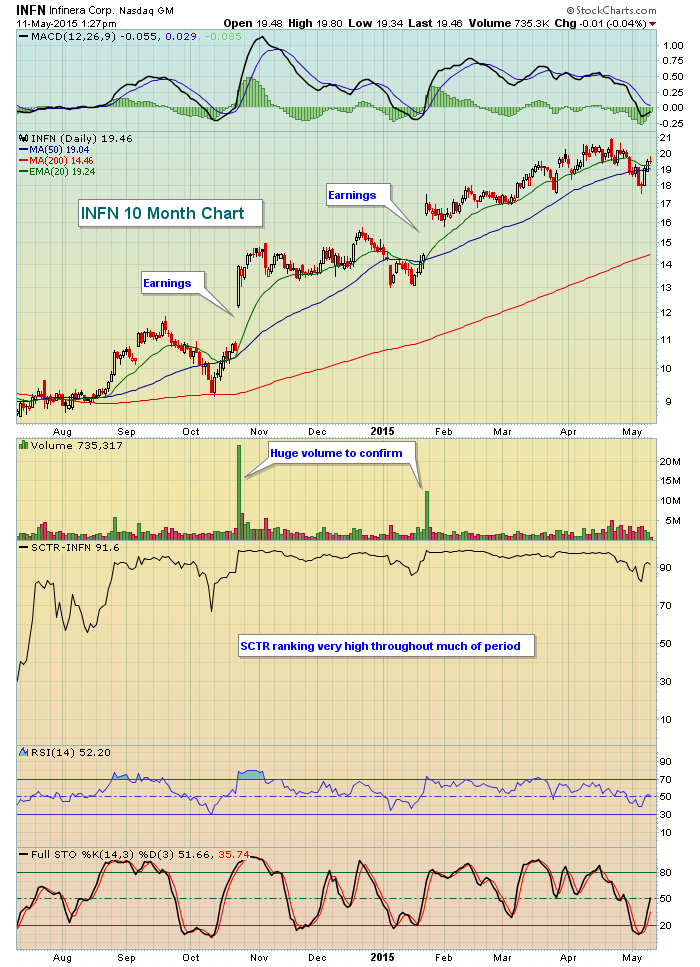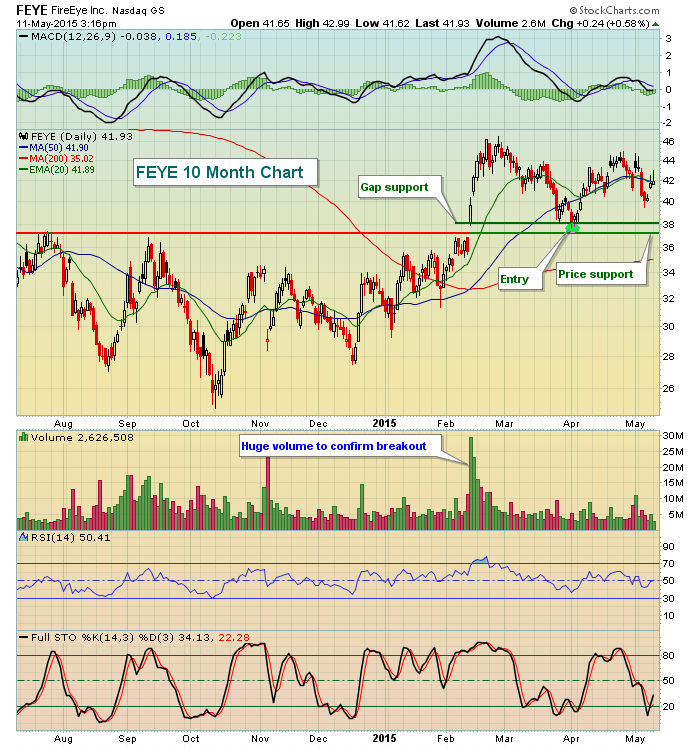 The best stock traders on the planet share one common ingredient. They manage risk. Managing risk can mean lots of things. You can manage risk by trading Exchange Traded Funds (ETFs) instead of individual stocks. This will help to eliminate, or significantly reduce, specific stock risk. If you don't like the idea of waking up to an earnings warning and 20% haircut on a stock you're holding, ETFs can provide you much more safety in that regard. You can manage risk by simply lessening your exposure to the stock market and diversifying into other asset classes like bonds, real estate, etc. You can manage your risk by the types of stocks you buy. Many of the Dow Jones component stocks have more reliable earnings than say small cap companies found on the Russell 2000 Index. As a result, their volatility is much lower making them inherently safer. You can manage risk by avoiding holding any stock into an important announcement like quarterly earnings results. You can manage risk by understanding the historical trends in the stock market and lowering your exposure to equities during periods of historical weakness. I think you're getting the point.
The best stock traders on the planet share one common ingredient. They manage risk. Managing risk can mean lots of things. You can manage risk by trading Exchange Traded Funds (ETFs) instead of individual stocks. This will help to eliminate, or significantly reduce, specific stock risk. If you don't like the idea of waking up to an earnings warning and 20% haircut on a stock you're holding, ETFs can provide you much more safety in that regard. You can manage risk by simply lessening your exposure to the stock market and diversifying into other asset classes like bonds, real estate, etc. You can manage your risk by the types of stocks you buy. Many of the Dow Jones component stocks have more reliable earnings than say small cap companies found on the Russell 2000 Index. As a result, their volatility is much lower making them inherently safer. You can manage risk by avoiding holding any stock into an important announcement like quarterly earnings results. You can manage risk by understanding the historical trends in the stock market and lowering your exposure to equities during periods of historical weakness. I think you're getting the point.
Now let me tell you that I'm not talking about any of those ways to manage risk. I'm talking about reading the technical price action on a chart and KNOWING the best times to buy and sell. Period.
Technical analysis knowledge and the tools here at StockCharts.com give you everything you need to take control of your own personal financial decisions. Let me ask you this - who is more interested in seeing you succeed financially than you? Your broker? Well, I suppose your broker could be a family member or a good friend that has your best interests at heart, but more than likely he/she has one eye, possibly both eyes, on the commission being earned. Do you honestly believe CNBC cares about your retirement account and whether you're on track to meeting all your financial needs? Don't make me laugh please. Do you think the market makers that drive the short-term market inefficiencies care about your personal well being? I can promise you this one is a resounding NO! They'd sell off family members for a buck or two. Not only are they not interested in your personal finances, but they are doing everything possible to manipulate you and steal from you in a legal way.
If you were to start a business, do you believe that everyone - including your competition - is wishing you success? Of course not. Your competition will do everything possible to shut your business down. They'll steal your clients, your products, your marketing strategies, literally anything they can get their hands on to add to your demise. In trading, these people are called market makers. They have trading accounts like you and me, with a few little perks like being able to see order flow and MASSIVE capital. They want to squash you and me, take our money and then hope we can come up with more money to give them at a later date.
I hate to be so harsh, but behind the scenes this is what is going on and as traders looking to make money, we need to take steps NOW to protect our financial future and to make money now from the knowledge we have of market makers. Let me make one thing crystal clear. You WILL NOT beat market makers at their game, but there's no reason we can't join them. :-)
I'm going to give you 5 simple steps to make money trading individual stocks. I am assuming that you are willing to take the risk of trading individual stocks and this is clearly a personal decision, not one that I can make for you. Drum roll please.
1. Identify Fundamentally Sound, Liquid Companies
"Ummmm Tom, I thought you said technical analysis and tools at StockCharts.com are all I needed?" Okay, that's 99% of what you need. My bad. My CPA background clouds the picture every once in awhile. This is a personal choice of mine, it doesn't have to be your method. I simply have more confidence trading a stock when management has been executing its business strategy and the company has reported stronger than expected revenues and earnings. I don't trust companies that set goals and fail. It adds another element where you have to evaluate the merit of their excuses, which is a drain of time and energy. There are thousands of companies in the stock market, so why not reduce that number by a significant percentage and focus solely on the companies that are executing? Sounds simple enough. Check out this chart of Infinera Corp (INFN):

I will be having a special Wednesday webinar at Noon EST. During that webinar, I'll demonstrate how I find companies that fit this revenue and earnings profile and I'll also demonstrate how easy it is to create a ChartList to organize these companies so that they're easy to review often. See below for a registration link and plan to join me if you can.
I try to make sure that any company that I add to my ChartList is liquid as well, meaning that they generally trade at least 200,000 shares a day. Illiquid stocks will many times be heavily manipulated and if our goal is to manage risk, this effectively eliminates those types of stocks from consideration.
2. Create A ChartList
Once you've done some homework and found the types of companies that you want to trade, WAIT for a good entry point. We don't want to forget about companies that we'd like to trade so that's why we want to establish a ChartList. Rather than explaining this process step-by-step, please refer to this prior blog article by CLICKING HERE.
3. Await A High Reward To Risk Entry Point
"Reward to risk" refers to a calculation based on three factors - entry point, target and closing stop. I prefer using closing stops over intraday stops as market makers will routinely drop prices beneath key levels of price support intraday only to see them reverse later in the trading day. Intraday stops will many times get you stopped out on a day where a stock makes a low. That is frustrating. Let me give you an example of the type of trade I'd be interested in and how I manage the trade. As an example, let's look at FireEye (FEYE):

First, FEYE reported better than expected revenues and earnings in mid-February so I added the stock to a ChartList with most of the annotations above as a simple reminder. The technical reaction to its earnings report was very positive, which I like to see. Keep in mind that when everyone wants to buy a stock on good news, a stock gaps higher and market makers provide liquidity and short the stock. That's why we see so many gaps "fill". In this case, however, FEYE gapped higher and kept running higher, a sign of accumulation in my opinion. The volume the next few days adds to that belief. The best entry for FEYE wasn't until April 2nd, six weeks later, as it tested gap support at 38.04 on much lighter volume. Note also that the RSI had fallen back to the 40 level after it previously neared 80. It's always very tempting to buy stocks that are in favor, but it's usually best to resist that temptation until they've had a period of consolidation or selling. The beauty of waiting to enter at 38.04 is that now we have a few different potential targets. We could sell when FEYE moves back to test its moving averages from underneath (occurred a few days after entry) or when it moves back to test the mid-March high just beneath 44.00 or we could still be holding out for a test of the late February highs just above 46.00. The point is we've entered at a much lower level and a close much below 38.00, certainly 37.00, would be a warning sign to exit and move to the sidelines. You should be able to see that the amount to be risked on this trade is FAR LESS than the potential reward. Every trade needs to be designed with your reward to risk in mind. If you have difficulty with it, paper trade and journalize it until you become more comfortable.
In general, I make sure my reward to risk is at least 2:1, preferably 3:1 or 4:1 or higher.
4. Set Your Closing Stop (or Intraday Stop)
As mentioned above, you MUST consider where you will exit the trade with a loss before you ever enter it. Many traders determine their position size by working backwards from the amount they're willing to risk on a trade. For instance, let's say that I have a $100,000 trading account and I'm willing to lose $500 on this trade. If I enter the trade at 38.04 and use a 37.00 closing stop, then I could potentially trade approximately 500 shares of FEYE. If I get stopped out, my loss will be just above that $500 threshold. One word of caution: If you're using a "closing stop", FEYE could CLOSE at 36.00 on a bad day and your loss could accelerate to $1,000. Please understand that this is an added risk of using closing stops. It avoids being whipsawed out of a trade that represents market maker manipulation on an intraday reversal, but the downside is a poor finish can trigger additional losses. You can offset that somewhat by trading fewer than the shares calculated.
5. TAKE PROFITS
You might think this would go without saying, but it needs to be communicated over and over and over again. You've done your homework, you've displayed patience, you've committed your capital with a solid reward to risk entry.....make sure you take profits if you make the right call. Trust me, I know the demons that creep into your head. "I'm up 10%, but I might be able to get another 10%." I urge you to think about your mental state at the time of the trade. When you first committed capital, you would have been delighted to take that 10% and RUN! But the mind is a very strange and powerful thing. Everything gets twisted after awhile. Do your best to remember the discipline in entering the trade. You need that same discipline in exiting. This profit capturing does a couple things. First, it frees up more capital to trade future opportunities. But more importantly, it INCREASES your capital and confidence.
Join me for my webinar to be held Wednesday, May 13, 2015 at Noon EST. Registration is free and you can CLICK HERE to register. Also, to the right of my blog make sure you subscribe to my blog (and others here at StockCharts.com) by clicking on "Email updates", typing your e-mail address and hitting the "Subscribe" button. It's simple!
Happy trading!
Tom






